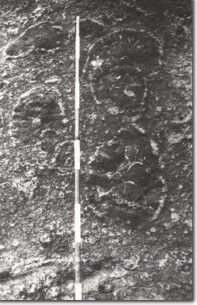Bb2 Russells Bridge - Pillow Lavas
|
This information has been developed from the publications:
|
| Location | Bannockburn - 522890. Former Shire of Bannockburn. 200 m north of Russells Bridge, 4 km south of Bannockburn. |  Bb2 - Pillow lavas at Russells Bridge, Moorabool Valley. |
Access | Bannockburn-Maude Road off Midland Highway. | |
Ownership | Crown land. | |
Site Description | The road cutting north of the bridge exposes an 8 to 10 m section in a lava flow of the Maude Basalt Member of the Maude Formation. Although somewhat weathered, the section displays well preserved pillow lavas. Large ovoid structures or pillows up to 1 m in diameter have a hard rim of volcanic glass surrounding decomposing basalt. The pillows are traversed by radial fractures infilled by secondary carbonates. | |
Significance | State. This is one of the few displays of pillow lavas in Victoria and the only recorded pillow lavas in Victoria and the only recorded pillow lava site in Older Volcanic rocks. The presence of the pillows indicates the lava at this point entered a body of water and probably marks the limit of the marine shoreline in the Early Miocene. This is important in determining the Tertiary palaeogeography of the Geelong-Maude area. | |
Management | Class 1. It is important that any road maintenance or widening operations do not destroy the face in this cutting. Careful engineering evaluation is necessary before any change is made to the section currently exposed. Any management in this regard should be designed to maintain a steep face on the cutting and not develop a covered or otherwise artificially stabilized slope. | |
References | Bowler, J.M. (1963).Tertiary Stratigraphy and Sedimentation in the Geelong/Maude Area, Victoria. Proc. R. Soc. Vict. 76:69-137. | |


